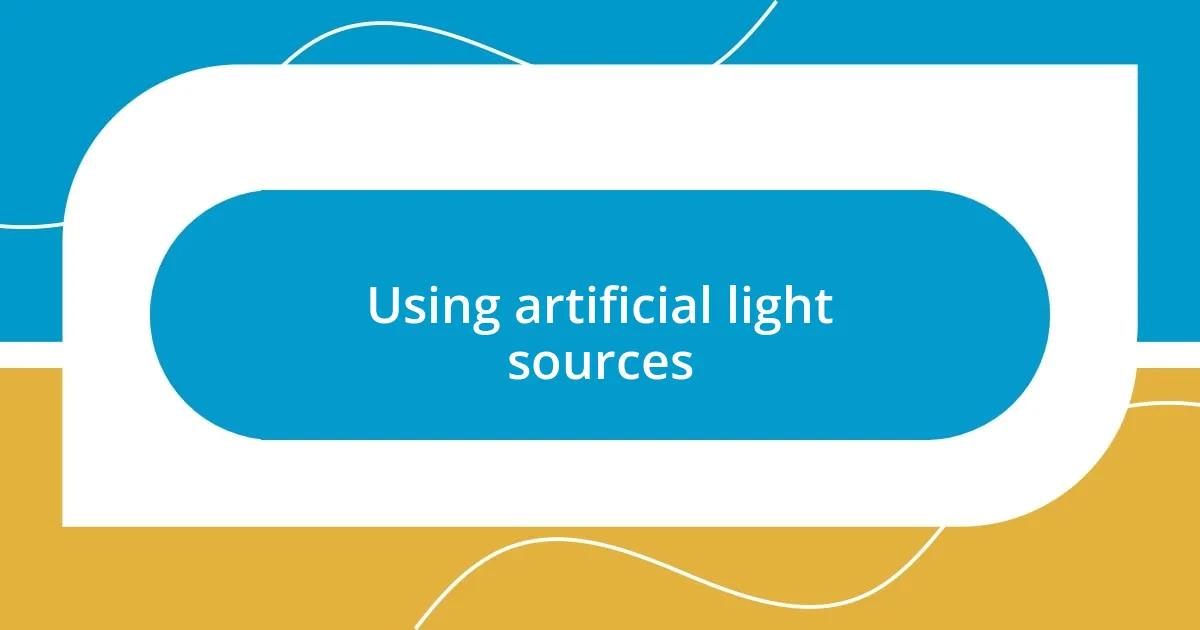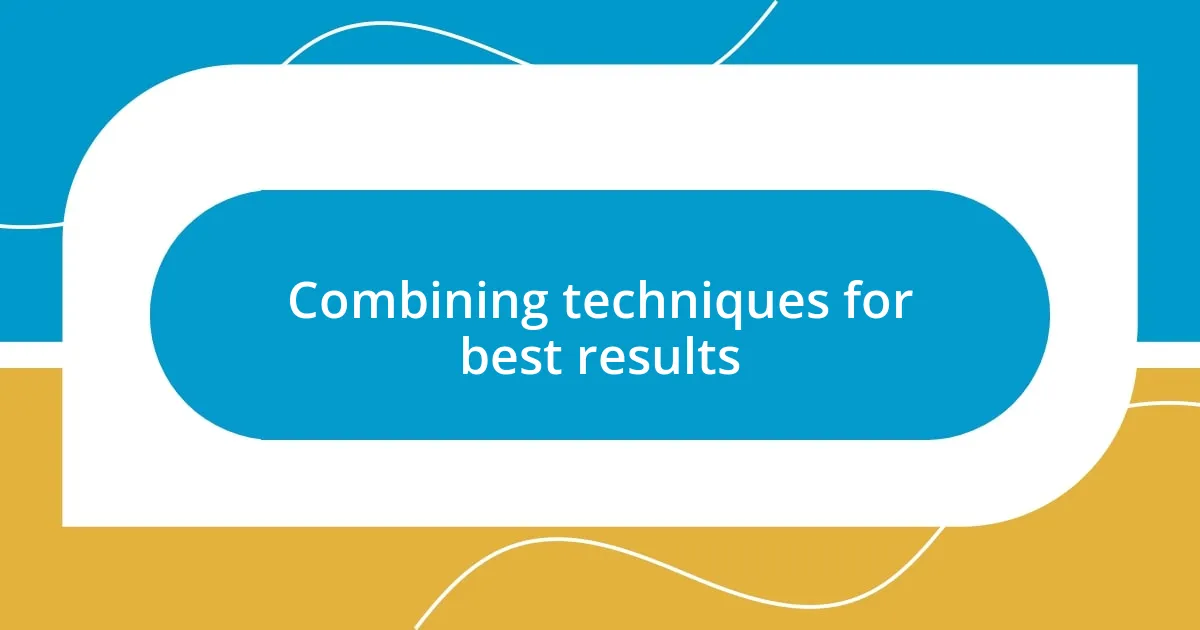Key takeaways:
- Understanding various lighting techniques, both natural and artificial, can dramatically influence the mood and emotion in portraits.
- Using modifiers like reflectors and softboxes can enhance light quality, helping to create depth and inviting expressions in subjects.
- Combining lighting techniques, such as backlighting with reflectors or mixing ambient light with flash, can produce striking and dynamic results in photography.
- Shadows play an important role in adding depth, intrigue, and emotional atmosphere to portrait imagery.

Understanding portrait lighting techniques
Understanding portrait lighting techniques is crucial for any photographer looking to capture the essence of their subjects. I remember a shoot where the lighting was perfectly diffused by clouds, creating a soft glow that worked wonders on my model’s skin tone. It made me realize how much natural light can influence the mood and emotion of a portrait – do you ever think about how light can transform a simple photo into something truly captivating?
I’ve experimented with various types of lighting, from harsh midday sun to warm golden hour light, and each brings its own unique character to a portrait. One time, I opted for side lighting, casting dramatic shadows that highlighted the contours of my subject’s face. It added depth and intrigue, making me wonder: isn’t it fascinating how the direction and quality of light can change the narrative of a moment?
Additionally, understanding the interplay of shadows and highlights is vital. I recall using a reflector during a shoot to bounce light back onto my subject’s face, softening the shadows. This simple technique not only enhanced the clarity of the eyes but also created a more inviting expression – have you ever noticed how a slight adjustment in lighting can breathe life into a photograph?

Natural light techniques for portraits
When it comes to natural light techniques, there’s something magical about utilizing the sun in different ways. I often find myself chasing that golden hour light, where the sun dips close to the horizon and bathes everything in a warm glow. Just last week, I captured a portrait of a friend in this light, and the results were breathtaking—his smile practically radiated warmth and happiness.
Here are some effective natural light techniques I frequently use for portraits:
- Backlighting: Position your subject with the sun behind them for a dreamy halo effect. This technique emphasizes their features beautifully and creates a soft, ethereal look.
- Open Shade: Shooting in the shade on a bright day helps avoid harsh shadows. I once took portraits under a tree, resulting in soft, diffused light that brought out my subject’s eyes.
- Reflectors: Utilizing a reflector can direct light back onto your subject’s face. I’ve seen how a simple piece of white foam board can elevate the overall look by creating a more balanced exposure.
- Golden Hour: This hour adds warmth and depth. I’ve made it a point to always schedule shoots for this time, as the colors of the sunset bring a captivating quality that’s hard to replicate.
Ultimately, it’s about discovering how natural light plays with emotional expression. Each technique allows you to tell a unique story through your portraits, and that’s something I truly cherish.

Using artificial light sources
Artificial light sources can open up a whole new world of creativity in portrait photography. I recall a time when I set up a shoot in my living room using just a simple softbox. The result was mesmerizing—soft, even light that highlighted the details of my subject’s expression beautifully. It really made me appreciate how such tools could mimic natural light conditions, creating an intimate atmosphere even in an indoor setting.
While natural light has its charm, there are numerous advantages to using artificial light. For instance, the ability to control the intensity and direction of light allows for dramatic effects that can completely transform a portrait. I once used a ring light to capture a beauty portrait, illuminating my subject’s features in a way that made her eyes sparkle like never before. I find that this kind of targeted lighting adds a dynamic element to the photo, allowing the artistry of illumination to play a starring role in the final image.
Moreover, combining various artificial light sources can yield creative results. I remember experimenting with colored gels on a strobe light during a themed shoot. The vibrant hues cast interesting shadows and highlighted my subject’s features in a striking way. This experience reinforced my belief that the variety and versatility of artificial light sources truly empower a photographer to express their vision. Have you considered how incorporating artificial light can elevate your portraits to new artistic heights?
| Type of Light Source | Advantages |
|---|---|
| Softbox | Provides soft, diffused light ideal for portraits. |
| Ring Light | Offers even illumination, enhancing brightness and sparkle in the eyes. |
| Strobe Light | Allows for high-intensity bursts, perfect for high-speed photography. |
| LED Panel | Portable with adjustable color temperatures; great for creative effects. |

Modifying light for effect
Modifying light is essential for achieving the desired effect in portrait photography. I remember a specific shoot where I used a scrim to soften harsh sunlight filtering through a window. The results were transformative. The light became gentle and flattering, embracing my subject’s features in a way that created a serene and calming atmosphere. How often do we underestimate what a simple modification can do?
When it comes to light modifiers, I’ve had great success with grids on my softboxes. They help to focus the light and reduce spill, giving me that delicate control I crave. I tried this during a portrait session with a shy model; by directing the light just right, I was able to bring out the depth in her eyes without overwhelming her with bright light. This precise adjustment brought a sense of intimacy that struck a chord with her. Have you ever noticed how a slight tweak in light direction can change the mood entirely?
Another technique I love is bouncing light off walls or ceilings. I often find myself in tight spaces, so I’ve taken to using my LED panel to bounce light off nearby surfaces for a soft, ambient glow. Once, while shooting in a cozy café, I aimed my light towards a white ceiling. It created an enchanting effect that made my subject look almost ethereal. I’ve found that this technique not only enhances the subject but also adds an organic quality to the environment around them. Isn’t it fascinating how light can transform not just people but the spaces we inhabit?

Creative uses of shadows
One of my favorite tricks is using shadows to create depth and intrigue in portraits. I once shot a model against a textured wall during golden hour, and by positioning her slightly off-center, I crafted elongated shadows that added a layer of drama to the scene. The shadows danced around her, making her the star of the show while also telling a story without words. Have you ever noticed how shadows can evoke emotions just as much as light?
I also enjoy utilizing shadows to highlight the contours of the face. In one memorable session, I used a single light source placed strategically to the side, casting soft shadows across the cheekbones of my subject. It was a breathtaking moment; the way the light and shadow interacted gave her a sculpted appearance, almost like a living piece of art. This experience taught me that shadows have a unique way of delineating features, adding a striking elegance to portraiture. Isn’t it amazing how something as simple as positioning can change the entire narrative of a photograph?
Lastly, I often play with shadows to create emotional atmospheres. For example, I was once inspired by a rainy day to shoot indoors, where I used shadows from a nearby window to create a moody, intimate scene. The diffused light filtering through the raindrops added a cinematic feel, enveloping my subject in a world of reflections and soft edges. Through this experience, I discovered that shadows can evoke feelings of vulnerability and introspection. Have you explored how manipulating shadows can transform not just the subject but the very essence of your portrait?

Mastering light placement
Mastering light placement is all about understanding the relationship between your light source and your subject. I recall a portrait session where I positioned my softbox slightly above and to the side. The light cascaded down gently, illuminating my subject’s face beautifully while accentuating her jawline. Have you ever tried adjusting the height of your light? It can completely alter the mood and feel of the portrait.
I’ve also experimented with different distances from the light source. Once, while photographing a friend, I took a step back to let the light spill more broadly. The result was a stunning, natural glow that wrapped around her features, making her appear more relaxed and approachable. This often-underestimated technique can add a layer of softness that’s equally inviting and engaging. Isn’t it fascinating how distance can impact the light’s effect on your subjects?
There’s also something magical about backlighting. I distinctly remember a sunset shoot where I positioned my subject directly in front of the setting sun. It created a halo effect, emphasizing her outline and giving her an almost ethereal presence. This technique not only highlighted her features but also instilled a sense of warmth and intimacy. Have you experimented with backlighting? It’s incredible how light can create such emotional depth in an image.

Combining techniques for best results
Combining different lighting techniques can yield breathtaking results that elevate your portraits. I remember a day when I decided to use both side lighting and a reflectors during a session. The result was striking: the natural light created depth while the reflected light softened any harsh shadows, making my subject glow. Have you thought about how the interplay of various lighting methods can enhance your work?
Another memorable experience I had was blending high and low key lighting. I once captured a portrait where I lit one side of my subject with a high-key setup for an airy feel while leaving the other in shadow. This contrast added an element of mystery and intrigue, compelling viewers to engage with the image more deeply. Isn’t it interesting how combining such techniques can profoundly impact the story a single photograph tells?
I’ve also explored mixing ambient light with a flash for dynamic results. On a rainy day, I employed a flash to illuminate my subject against the overcast backdrop, creating a vibrant contrast that breathed life into the moody setting. This combination not only highlighted her features but also added a sense of drama to the overall scene. Have you ever combined ambient light with artificial sources? The synergy can transform an ordinary moment into something extraordinary.












